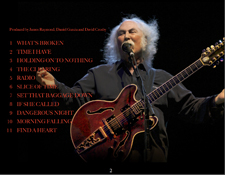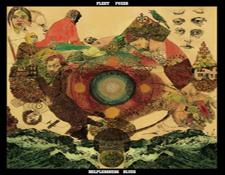It’s the time of year for saving money!
 Apologies to those of you who have heard me say — and write — this before, but if I hear one more person say “there is no good music being made anymore” I’m a-gonna scream.
Apologies to those of you who have heard me say — and write — this before, but if I hear one more person say “there is no good music being made anymore” I’m a-gonna scream.
Or as Charlie Brown might have said back in the day: “Argggggh!”
I say this as I am playing the new fine album by rock folk pioneer David Crosby via a sweet super high resolution 192 kHz, 24-bit HDTracks download. All that audiophile stuff aside for a bit, Croz — as the album is named — is as good a slab of music as the man has made since his peak duo days with Graham Nash and trio-quartet combinations with Stephen Stills and Neil Young in the mix. Close your eyes and listen to a track like “Radio” and it could have been one of those songs you heard on FM radio back in the early and mid 1970s. Its got that harmony-hook thing down pat in classic Crosby & Nash fashion ala “Immigration Man” (a Top 40 hit in 1972) and “Carry Me” from 1975, with its “Look down, look down, and reach your hand into the water” refrain.
 Other tracks on this really sweet album can sit side by side Crosby classics from his first solo album “If I Could Only Remember My Name” (#12 on the album pop charts in 1971 and one of this writers favorite — ever — surround sound releases in its 2006 DVD Audio reinvention). I bring up that album since many of you boomers might only be familiar with that one and unaware that he put out great albums with his band CPR in “recent” years as well as a fine fine two CD set with Graham Nash in 2004 that was criminally ignored by most people.
Other tracks on this really sweet album can sit side by side Crosby classics from his first solo album “If I Could Only Remember My Name” (#12 on the album pop charts in 1971 and one of this writers favorite — ever — surround sound releases in its 2006 DVD Audio reinvention). I bring up that album since many of you boomers might only be familiar with that one and unaware that he put out great albums with his band CPR in “recent” years as well as a fine fine two CD set with Graham Nash in 2004 that was criminally ignored by most people.
Like most Crosby albums this album swings between passionate rock and moody, ambient introspective acoustic pieces. I dare not call it folk because this music is more akin to jazz — I’ll put it this way, if you like artists like Rickie Lee Jones, you might just like David Crosby’s music which probably was an influence on her. This album even has Wynton Marsalis guesting on one track, “Holding On To Nothing” as well as the great Mark Knopfler on album opener “What’s Broken.”
The sound on this release is remarkably warm for a recording that was likely (my guess) recorded all digitally — it was made at multiple studios — proof that digital doesn’t have to equate harsh and bad. A “beautiful” Neumann microphone was used to record Crosby’s vocals, according to the liner notes. Recording at this level of resolution and with the right sorts of outboard treatment along the way in terms of processing and microphone choices (as mentioned above), the music comes out full, warm and engaging.
 Crosby’s voice is still as clear as a bell, remarkable for a man who has been through as much as he has physically — but clearly he’s taken care of his vocal chords over the years and clean living has no doubt helped him maintain that purity. Some tracks have that sort of wonderful moodiness of Crosby classics like Gueneviere (from the first CSN album), such as the electric guitar and voice piece “If She Called.” This album isn’t all retro however, as Crosby works with beats on “Dangerous” yet keeps a decidedly Crosby-esque feel. Listen to a track like “Morning Falling” and you’ll make the jump from Jeff Buckley to Radiohead to CSN and back again.
Crosby’s voice is still as clear as a bell, remarkable for a man who has been through as much as he has physically — but clearly he’s taken care of his vocal chords over the years and clean living has no doubt helped him maintain that purity. Some tracks have that sort of wonderful moodiness of Crosby classics like Gueneviere (from the first CSN album), such as the electric guitar and voice piece “If She Called.” This album isn’t all retro however, as Crosby works with beats on “Dangerous” yet keeps a decidedly Crosby-esque feel. Listen to a track like “Morning Falling” and you’ll make the jump from Jeff Buckley to Radiohead to CSN and back again.
It’s all about continuum, folks.
]]> And that continuum was never more apparent in the fine 2011 album Helplessness Blues by Fleet Foxes, an album I’ve had on CD for sometime but waited to review it until I had the chance to get it on vinyl. Fleet Foxes are very much a new millennium take on the CSN type of sound — well, at least the CSN tracks that were driven by Crosby’s sensibilities of free jazz timing, interesting chords and insightful lyrics. Multi part harmonies, big sounding acoustic guitars and some percussion are recorded with an enormous ambiance as if the album was made in a big church or a warehouse.
And that continuum was never more apparent in the fine 2011 album Helplessness Blues by Fleet Foxes, an album I’ve had on CD for sometime but waited to review it until I had the chance to get it on vinyl. Fleet Foxes are very much a new millennium take on the CSN type of sound — well, at least the CSN tracks that were driven by Crosby’s sensibilities of free jazz timing, interesting chords and insightful lyrics. Multi part harmonies, big sounding acoustic guitars and some percussion are recorded with an enormous ambiance as if the album was made in a big church or a warehouse.
In terms of vocal sound, Fleet Foxes’ lead singer Robin Pecknold has more in common with Graham Nash than Crosby but the music is cut from similar cloth in many ways, with bits of early Van Morrison thrown in for good measure. With subtle Celtic twists here and there, the album ebbs and flows. Honestly, if I put on a track like “Sim Sala Bim” and told you blindly it was a new Crosby-Nash track, you’d probably say “cool!” This is heady interesting stuff worthy of your exploration.
 Sonics wise, Helplessness Blues is very curious. The CD sounded really good to begin with. The HDTracks 96/24 download sounds quite fabulous, clean clear and quiet with just a hint of digital crisping up the otherwise lush and well recorded sound. The two disc LP version sounds almost identical to the 96/24 download (leading me to believe the discs were created from the same files). It is pressed on nice — probably 150 gram, I am guessing — black vinyl that is pretty much dead quiet and perfectly centered; I heard some soft surface noise on the run off grooves and maybe a little between one or two songs, but nothing horrible.
Sonics wise, Helplessness Blues is very curious. The CD sounded really good to begin with. The HDTracks 96/24 download sounds quite fabulous, clean clear and quiet with just a hint of digital crisping up the otherwise lush and well recorded sound. The two disc LP version sounds almost identical to the 96/24 download (leading me to believe the discs were created from the same files). It is pressed on nice — probably 150 gram, I am guessing — black vinyl that is pretty much dead quiet and perfectly centered; I heard some soft surface noise on the run off grooves and maybe a little between one or two songs, but nothing horrible.
All that said, I really like the LP version because it forces you get up and switch sides, taking a breather from the enormous density of music for a few moments and anticipating the next movement, if you will. I also like the album packaging which features beautiful cover artwork and in a huge fold out poster (black ink on a parchment colored paper). This package is so perfectly old school, you could have released this in 1971 alongside albums by CSN, Neil Young and Joni Mitchell. It would have fit right in.
So there you have it.
Don’t tell me there is no good music being made anymore, says this borderline Baby Boomer/Gen-Xer! Fleet Foxes and the new David Crosby album are fine examples that popular music is still moving in positive directions.
Mark Smotroff is a freelance writer and avid music collector who has worked for many years in marketing communications for the consumer electronics, pro audio and video games industries, serving clients including DTS, Sega, Sony, Sharp, AT&T and many others. www.smotroff.com Mark has written for EQ Magazine, Mix Magazine, Goldmine/DISCoveries Magazine, BigPictureBigSound.com, Sound+Vision Magazine and HomeTechTell.com. He is also a musician / composer whose songs have been used in TV shows such as Smallville and Men In Trees as well as films and documentaries. www.ingdom.com Mark is currently rolling out a new musical he’s written: www.dialthemusical.com.






